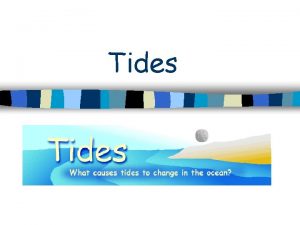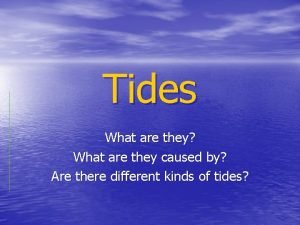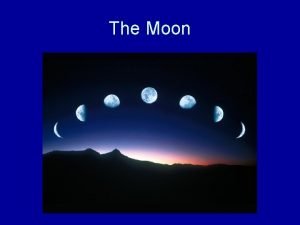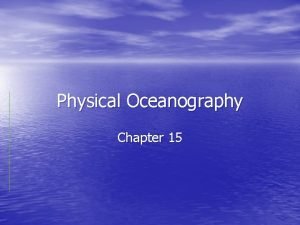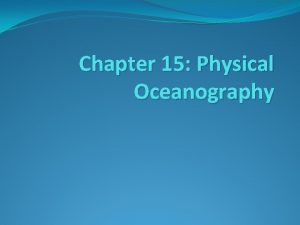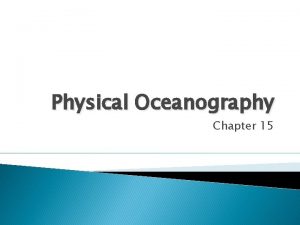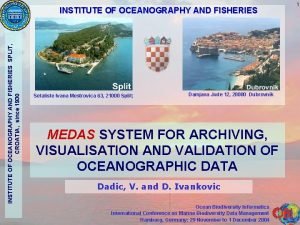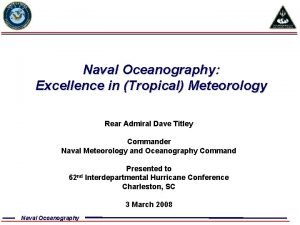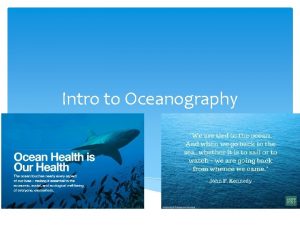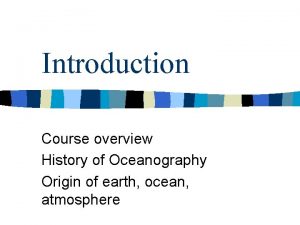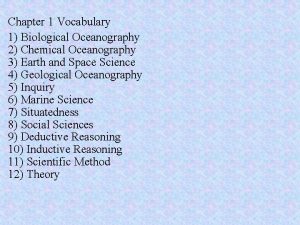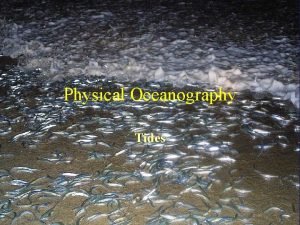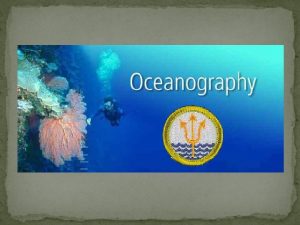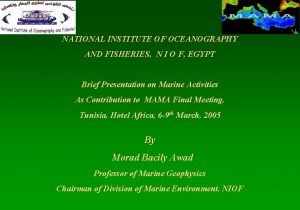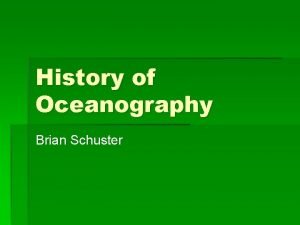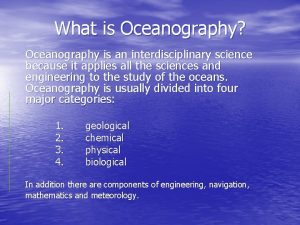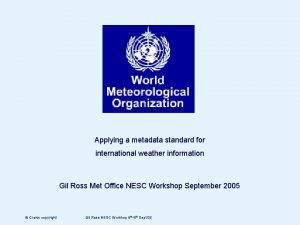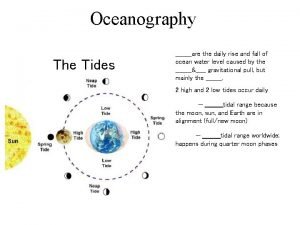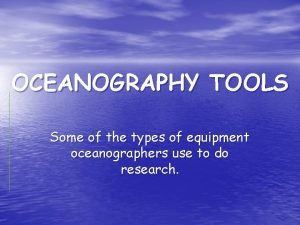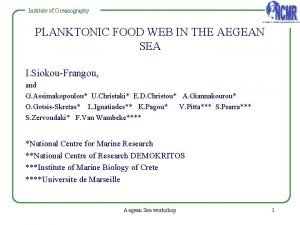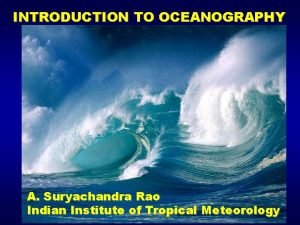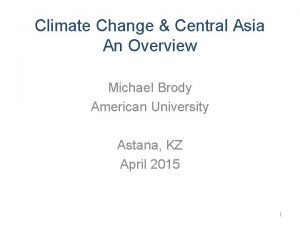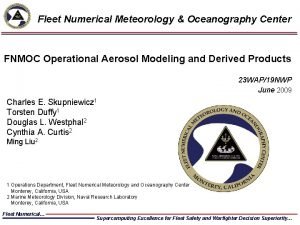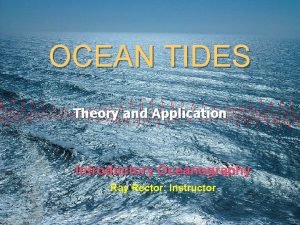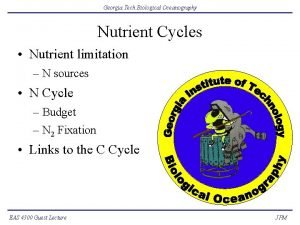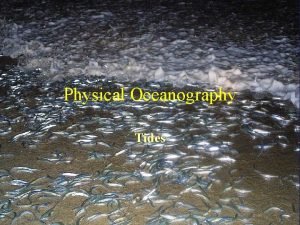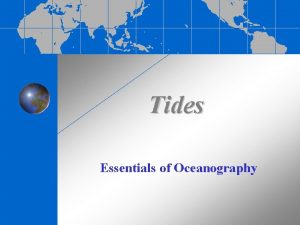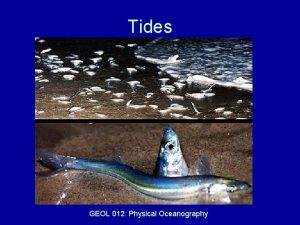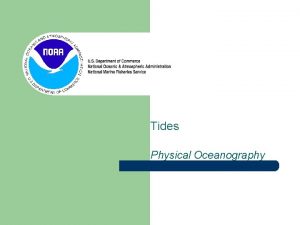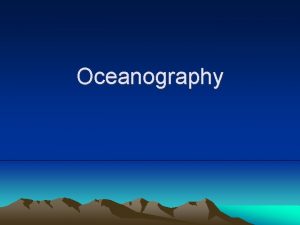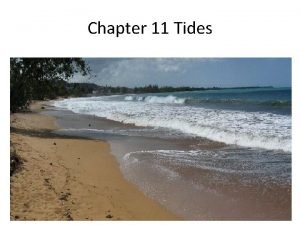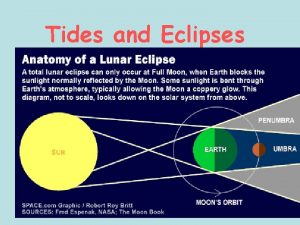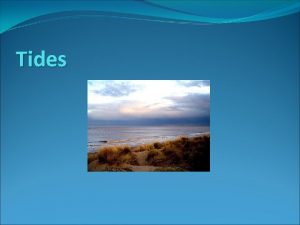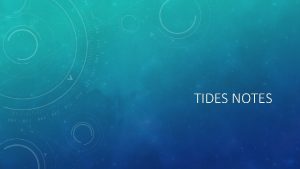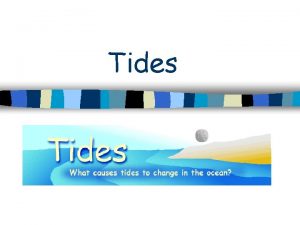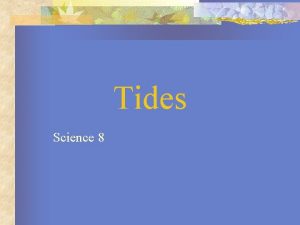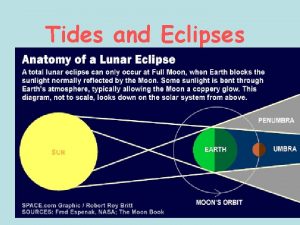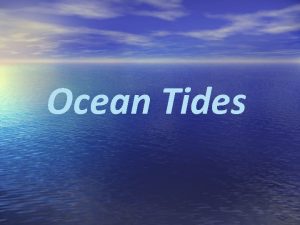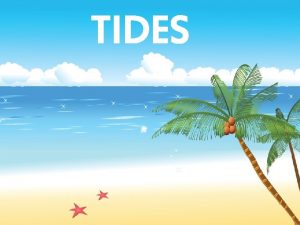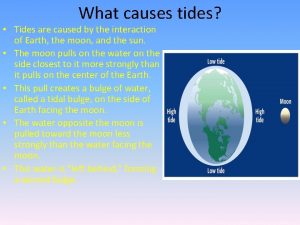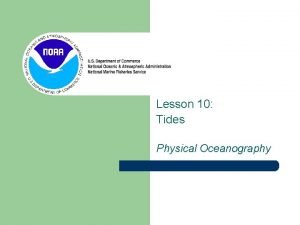Physical Oceanography Tides 1 31 Tides are caused






























- Slides: 30

Physical Oceanography Tides 1 / 31

Tides are caused by the gravitational force of the moon and sun and the motion of earth. The wavelength of tides can be half the circumference of earth. Tides are forced waves because they are never free of the forces that cause them. 2 / 31

Moon Tide Produced by the moon’s gravitation force on water A bulge of water is created by the moon’s gravitational force Centrifugal forces produces a bulge on the opposite side of the Earth & an area of low water between the tidal bulges 3 / 31

Source : Trujillo, Alan P. , Essentials of oceanography / Al Trujillo, Harold Thurman. 10 th ed 4 / 31

Lunar Day A lunar day is the time that elapses between when the moon is directly overhead and the next time the moon is directly overhead. 5 / 31

Spring Tides • During the period of a new moon, the moon and sun are lined up on the same side of the Earth • Produces the greatest range between high water and low water 6 / 31

Neap Tides • Produced when the moon is at a right angle to the line of centers of the Earth and the sun • The range between high and low water is small 7 / 31

Tide Patterns • Diurnal tide – One high and one low tide per day • Semidiurnal – Twice occurring high and low tide sequences – High and low tides are both at the same level • Semidiurnal mixed tide – Each high tide reaches different heights – Each low tide falls to different levels 8 / 31

Tide Patterns The worldwide distribution of the three tidal patterns. 9 / 31

Tide Patterns 10 / 31

Tide Patterns Examples of monthly tidal curves Top: Boston, Massachusetts, showing semidiurnal tidal pattern. Upper middle: San Francisco, California, showing mixed tidal pattern with strong diurnal tendencies. Bottom: Pakhoi, China, showing diurnal tidal pattern. 11 / 31

Tide Patterns • Amphidromic Points – A "no-tide" point in an ocean – About a dozen amphidromic points exist in the world ocean. – Sometimes called a node. 12 / 31

Amplitude is indicated by color, and the white lines are cotidal differing by 1 hr. The curved arcs around the amphidromic points show the direction of the tides, each indicating a synchronized 6 hour period. R. Ray, TOPEX/Poseidon: Revealing Hidden Tidal Energy en: GSFC, en: NASA 13 / 31

Animated map of the tidal nodes of the Earth 14 / 31

. Tides in Confined Basins The tidal range is determined by basin configuration 16 / 31

Tides in Confined Basins Tides in a narrow basin. Note that a true amphidromic system does not develop because space for rotation is not available. 17 / 31

Bay of Fundy, Nova Scotia World’s Largest Tidal Range Spring Tide Timelapse, Halls Harbour Video: https: //youtu. be/hbzwzr. Z XUKA 18 / 31

The tide was rising in the Bay of Fundy when the two MODIS sensors (on the Terra and Aqua spacecraft) flew overhead on April 15, 2009. Terra flew by a little over an hour after low tide, and Aqua flew past an hour and 47 minutes later. 19 / 31

Source: 1

Tidal Bore - A true tidal wave "River Ribble bore" by Frangle Plazma Goat - Own work. Licensed under CC BY-SA 3. 0 via Wikimedia Commons 21 / 31

Tidal terms & currents 22 / 31

Tides and Marine Organisms 23 / 31

Tides and Marine Organisms • Grunions! (Leuresthes tenuis) – Spawn from late February to early September 24 / 31

25 / 31

Tidal Power • Tidal energy can be exploited in two ways: – By building semi-permeable undersea tidal turbines across estuaries with a high tidal range. – By harnessing offshore tidal streams 26 / 31

Tidal Power 27 / 31

List of World Main Tidal Power Stations Country Power Station Tidal Loss (m) Capacity (MW) Operated Since France Langce 8. 5 240 1966 Canada Andeboriece 7. 1 1984 Former Soviet Union China Gicelaya 3. 9 0. 4 1968 Jiangxia 5. 1 3. 2 1980 China Baishakou 2. 4 0. 64 1978 China Xingfuyang 4. 5 1. 28 1989 China Yuepu 3. 6 0. 15 1971 China Haishan 4. 9 0. 15 1975 China Shashan 5. 1 0. 04 1961 China Liuhe 2. 1 0. 15 1976 China Guozishan 2. 5 0. 04 1977 28 / 31

Tidal Power • La Rance, France - world's first tidal power plant – Average tidal range 27 feet – Dam encloses 8. 5 sq. miles – Capacity is 320, 000 KW 29 / 31

Tidal Power • Low Production but also Low Environmental Impact – No noxious waste – No consumption of resources – Minimum disturbance to scenery 30 / 31

~ End ~ 31 / 31
 Mikael ferm
Mikael ferm The difference between spring tides and neap tides
The difference between spring tides and neap tides Spring tide position
Spring tide position What are tides and how are they caused
What are tides and how are they caused 4 phases of the moon
4 phases of the moon Chapter 15 physical oceanography
Chapter 15 physical oceanography Chapter 15 physical oceanography
Chapter 15 physical oceanography Chapter 15 physical oceanography
Chapter 15 physical oceanography Split institute of oceanography and fisheries
Split institute of oceanography and fisheries Oceanography
Oceanography Chemistry oceanography
Chemistry oceanography 5 branches of oceanography
5 branches of oceanography History of oceanography
History of oceanography Chemical oceanography definition
Chemical oceanography definition Essentials of oceanography
Essentials of oceanography Describe
Describe Institute of oceanography and fisheries
Institute of oceanography and fisheries Polynesians oceanography
Polynesians oceanography Why is oceanography an interdisciplinary science
Why is oceanography an interdisciplinary science Chemistry oceanography
Chemistry oceanography Oceanography
Oceanography Oceanography tools
Oceanography tools Oceanography
Oceanography Oceanography
Oceanography Scripps institute of oceanography
Scripps institute of oceanography University of hawaii oceanography
University of hawaii oceanography Copyright search
Copyright search Semidiurnal tide
Semidiurnal tide Fnmoc meteorology products
Fnmoc meteorology products Neap tide spring tide
Neap tide spring tide Oceanography
Oceanography

